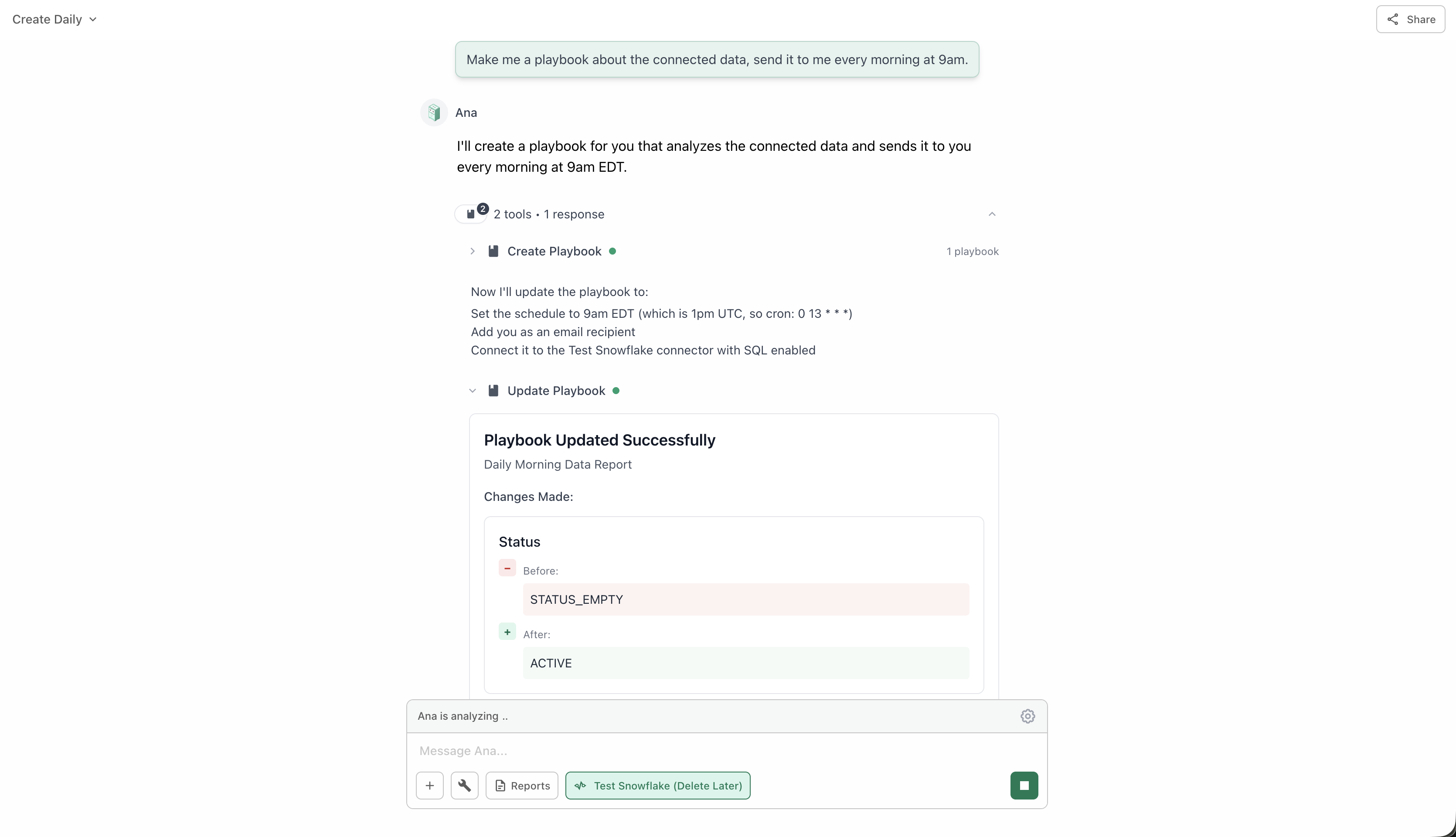Automation Made Easy: Turn any analysis into a recurring workflow that runs automatically and delivers insights to your team.

Creating and updating a playbook
Available Operations
When the Playbooks tool is enabled, Ana can perform these operations:List Playbooks
View all playbooks in your organization to understand what automations exist and their current status.
Get Details
Retrieve detailed information about a specific playbook including configuration, schedule, recipients, and execution history.
Create Playbooks
Build new automated workflows by defining the analysis, schedule, connectors, and delivery method.
Update Playbooks
Modify existing playbooks to change schedules, recipients, queries, or enable/disable them.
What Ana Retrieves When Getting Playbook Details
Configuration & Settings
Configuration & Settings
- Playbook name and description
- Enabled/disabled status
- Analysis or query definition
- Output format preferences
Schedule Information
Schedule Information
- Cron expression or event trigger
- Timezone settings
- Next scheduled run time
- Frequency (daily, weekly, monthly, etc.)
Data Sources
Data Sources
- Associated connectors
- Database connections used
- File sources referenced
Delivery Settings
Delivery Settings
- Recipients (email addresses)
- Slack channels
- Teams channels
- Other notification destinations
Execution History
Execution History
- Recent run times
- Success/failure status
- Error messages (if any)
- Duration of each run
What You Can Define When Creating Playbooks
1
Define the Analysis
Specify what analysis or report should run. This can be a SQL query, a data transformation, or a complete analytical workflow.
2
Set the Schedule
Tell Ana when the playbook should run using natural language:
- Daily: “Every day at 9 AM”
- Weekly: “Every Monday at 9 AM”
- Monthly: “On the first of every month at 9 AM”
3
Select Data Connectors
Choose which databases or data sources the playbook should query.
4
Configure Delivery
Set up how and where results are delivered:
- Email recipients
- Slack channels
- Microsoft Teams channels
- Output format (PDF, CSV, etc.)
When to Use
Enable the Playbooks tool when you need to:- Recurring Reports
- Scheduled Analysis
- Monitoring & Alerts
- Team Updates
Automate regular reporting cycles
- Daily sales dashboards
- Weekly performance summaries
- Monthly financial reports
- Quarterly business reviews
Common Use Cases
Daily Reports
Morning Metrics DeliverySend key metrics to stakeholders every morning before the workday begins.
- Sales performance
- Active users
- Revenue tracking
- Support tickets
Weekly Summaries
Week-over-Week AnalysisCompare current week performance against previous periods.
- Growth metrics
- Engagement trends
- Conversion rates
- Team productivity
Event-Driven Alerts
Proactive MonitoringGet notified when specific conditions are met.
- Low inventory warnings
- High error rates
- Unusual patterns
- Threshold breaches
Executive Dashboards
Leadership UpdatesAutomated reports for executives and board members.
- Monthly business review
- Quarterly performance
- Annual trends
- Strategic metrics
Best Practices
1
Test First
Create and test your analysis in a regular chat before turning it into a playbook. Verify:
- Query logic is correct
- Results are formatted properly
- Visualizations render correctly
- Output is clear and actionable
2
Be Specific About Schedules
Use clear, natural language to describe when the playbook should run. Include timezone and frequency.Good Examples:
- “Run every Monday at 9 AM EST”
- “Send daily at 8:30 AM Pacific time”
- “Execute on the 1st and 15th of each month at noon”
- “Run weekly in the morning”
- “Send regularly”
- “Update periodically”
3
Choose Appropriate Recipients
Ensure the right people or channels get the right information. Consider:
- Who needs to see this data?
- What format do they prefer?
- What level of detail is appropriate?
4
Start Simple
Begin with straightforward reports before building complex workflows. You can always iterate and add complexity later.
5
Monitor Execution
Check playbook execution history regularly to ensure they’re running as expected:
- Review success/failure rates
- Check execution times
- Monitor for errors
- Verify deliveries
Schedule Examples
Just tell Ana when you want the playbook to run using natural language:Daily Schedules
- “Every day at 9 AM”
- “Daily at 8:30 AM EST”
- “Run at 6 PM every day”
Weekly Schedules
- “Every Monday at 9 AM”
- “Wednesdays and Fridays at 2 PM”
- “Weekly on Tuesday at 10 AM”
Monthly Schedules
- “First of every month at 9 AM”
- “On the 15th at noon”
- “Last day of the month at 5 PM”
Frequent Updates
- “Every 6 hours”
- “Every hour during business hours”
- “Every 30 minutes”
Related Documentation
Detailed Playbooks Guide
Learn more about playbooks, including advanced features, troubleshooting, and examples.